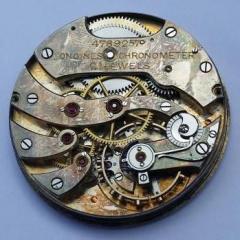Ronda 705 problem
-
Recently Browsing
- No registered users viewing this page.
-
Topics
-
Posts
-
I also still use my cheap first set of screwdrivers. I replaced the blades of the smallest (0.6mm) with higher quality once I had bent a few of the originals, but beyond that I have been fine. Note though that I do not work on any remotely valuable watches and most of what I deal with are in a truly terrible state, watches that have been banging around in kitchen drawers or toolboxes. So my concern for screw head slot integrity and scratches is usually not very high. As for a loupe - you won't need anything powerful for an ST36 that is new. You don't need to do close inspection of balance pivots because they will not be worn out, and a 3x or 5x loupe is perfectly sufficient to see the oiling. I don't have any microscope or powerful magnification of any sort. I just use cheap loupes. But again this would be different if I were working with more valuable watches. And if I had equipment to burnish pivots, then I would get a microscope to check my work.
-
By Neverenoughwatches · Posted
I've recently switched over to using a x2.5 -x3 eyeglass for disassembly and some larger part assembly. It's interesting to see how accustomed and trained your eyes become to that way of working after using a microscope for years. And pick up and work at eyelevel when possible. Personally I would stick with and learn to use regular oilers efficiently. -
Thank you Mark.
-
I remember playing with asbestos wire insultaion when I was a kid (remember the cool fluffy white stuff?) and I've been breathing fine dust particles in my woodworking shop for years, so I'm probably toast either way, but I don't want any of this radioactive dust anywhere near my kids.
-
By Neverenoughwatches · Posted
Its good to understand how and why demagnetisers work. These two pieces of text explain in basic terms how ferrous metal is affected by magnetism and why they can retain some of those properties. The cheap demagnetiser is actually a magnetiser,but is used in a way that can remove the weak magnetic properties that a steel has gained through magnetic field exposure. As steel is drawn further away from the device, the magnetic fields around it become progressively weaker and more -irregular- . This causes the disruption of the atomic and subatomic alignments within the steel that make it magnetised. So also moving the steel through different orientations as its pulled away could actually improve that process. I still use my first cheap set of drivers, I notice very little difference in the way of feel between them and a set of preowned Bergeon I use, blade quality is more important. Tweezers have more variables, but again they don't have to be expensive to work well. My most used tweezers are my cheapest, but then I never use any pair that I haven't modified in some way.
-




.thumb.jpg.19a9c4ff164d78d516aa9f05a063752b.jpg)


Recommended Posts